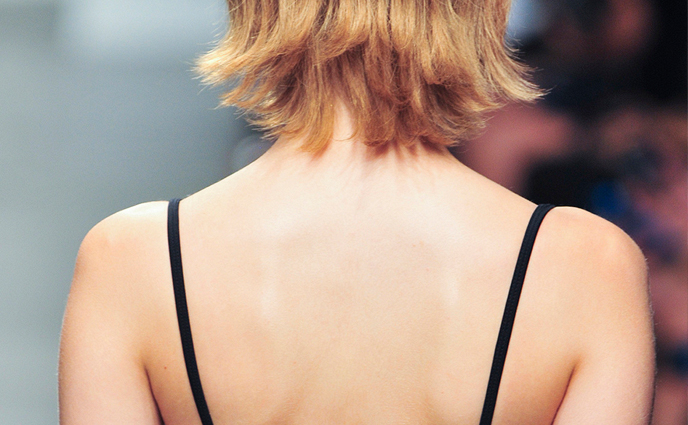Some of the most bacteria-laden objects in your environment are the ones that receive the most contact with your hands. In fact, your cellphone is one of the most pathogen-infested things you touch on a daily basis, notorious among dermatologists for its bacteria-transferring abilities.
"The area from the temple to the chin [is] referred to as the 'phone zone,'" says Frank. "Your phone holds onto germs and these germs can be transferred onto your skin."
Your Rx: Keep a box of antibacterial wipes in your desk or car caddy so you remember to wipe down your device a few times a week. Frank recommends regular exfoliation to unclog pores and lessen the likelihood that bacteria transferred from your phone will lead to a breakout.
"The area from the temple to the chin [is] referred to as the 'phone zone,'" says Frank. "Your phone holds onto germs and these germs can be transferred onto your skin."
Your Rx: Keep a box of antibacterial wipes in your desk or car caddy so you remember to wipe down your device a few times a week. Frank recommends regular exfoliation to unclog pores and lessen the likelihood that bacteria transferred from your phone will lead to a breakout.
Deep, "icepick" acne scars -- the ones that look like little crevices in the skin -- are some of the most difficult to treat. One of the most powerful solutions: Get rid of the skin altogether.
"In punch excision surgery, deep scars are treated using a punch biopsy tool," explains Peredo. Essentially, the dermatologist punches a hole in the skin just large enough to remove the affected skin. "Then, skin can either be sutured together or grafted with skin from behind the ear," says Peredo.
Your Rx: If you have mild to moderate icepick scarring, ask your dermatologist if you're a candidate for excision. Another option: Have your doctor inject the scar with fillers like Juvederm. The results are more temporary than punch excision, but they're immediate and the process is less invasive.
"In punch excision surgery, deep scars are treated using a punch biopsy tool," explains Peredo. Essentially, the dermatologist punches a hole in the skin just large enough to remove the affected skin. "Then, skin can either be sutured together or grafted with skin from behind the ear," says Peredo.
Your Rx: If you have mild to moderate icepick scarring, ask your dermatologist if you're a candidate for excision. Another option: Have your doctor inject the scar with fillers like Juvederm. The results are more temporary than punch excision, but they're immediate and the process is less invasive.
If you've tried a billion approaches to curing your adult acne with no success, consider what your gut may be telling you. In a recent study, patients with acne and rosacea produced less sebum and had fewer pimples after 12 weeks of drinking a Lactobacillus probiotic supplement.
Using probiotics, the so-called good bacteria, to fight skin issues is nothing new, says Goldfaden. "Topical use of probiotics or yogurt has been around for thousands of years," he explains. "Yogurt and probiotics are calming for redness and irritation and antimicrobial.... Trying it out cannot hurt."
Your Rx: Try probiotic-based skin-care products like Bliss No Zit Sherlock Acne Kit. Also look for probiotic supplements containing the strains Lactobacillus and Bifidobacterium and eat foods with live active cultures (like kefir, miso, kombucha and kimchi).
Using probiotics, the so-called good bacteria, to fight skin issues is nothing new, says Goldfaden. "Topical use of probiotics or yogurt has been around for thousands of years," he explains. "Yogurt and probiotics are calming for redness and irritation and antimicrobial.... Trying it out cannot hurt."
Your Rx: Try probiotic-based skin-care products like Bliss No Zit Sherlock Acne Kit. Also look for probiotic supplements containing the strains Lactobacillus and Bifidobacterium and eat foods with live active cultures (like kefir, miso, kombucha and kimchi).
If you want to go all "Star Wars" on your acne with in-office laser treatments, there are a handful of lasers that your derm might recommend to obliterate acne -- most likely, pulsed-dye, diode, fractional, infrared or KTP.
So how do they work? In the simplest terms, these lasers do one of three things: shrink your blood vessels to decrease redness; destroy sebaceous glands under the skin, causing it to produce less oil and, theoretically, fewer pimples; or resurface the skin to make scarred or uneven skin smoother and more even-toned.
Your Rx: If topical products or oral medications haven't helped your acne, tell your derm about the type of acne or scarring that you have, which will help guide her to picking the right zit-zapper for you. One drawback: Laser treatments aren't usually covered by health insurance.
So how do they work? In the simplest terms, these lasers do one of three things: shrink your blood vessels to decrease redness; destroy sebaceous glands under the skin, causing it to produce less oil and, theoretically, fewer pimples; or resurface the skin to make scarred or uneven skin smoother and more even-toned.
Your Rx: If topical products or oral medications haven't helped your acne, tell your derm about the type of acne or scarring that you have, which will help guide her to picking the right zit-zapper for you. One drawback: Laser treatments aren't usually covered by health insurance.
What causes acne, how to prevent acne from forming, and how to treat existing acne are three of the most mystifying issues in dermatology today. That's because acne can be influenced by such a weird amalgamation of factors -- from major influences like lifestyle, heredity and stress down to seemingly insignificant details like what you pour over your cereal in the morning. Here's everything we know about acne and how to cure it, from the foods that cause acne to pimple home remedies to antibiotics for acne.




